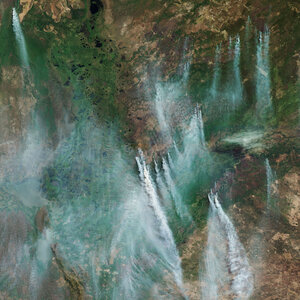

Bolivian forest: comparing Sentinel-2 and Biomass
ESA revealed the first stunning images from its groundbreaking Biomass satellite mission – marking a major leap forward in our ability to understand how Earth’s forests are changing and exactly how they contribute to the global carbon cycle.
This is an image in two parts, a capture of Bolivia from Biomass but featured below an image of the same area from Copernicus Sentinel-2.
Although the images appear visually similar, the Biomass image offers significantly more information for quantifying forest carbon stocks. This is primarily thanks to its long-wavelength radar, which can penetrate the canopy and characterise the entire forest structure. In contrast, the optical Sentinel-2 image captures only the top of the canopy.
The true strength of the Biomass mission lies not in identifying features from a single image, but in its unique sampling technique and ability to combine multiple observations of the same area to reveal forest height and biomass. This enables scientists to accurately quantify forest carbon stocks and better understand the role of tropical forests in the global carbon cycle.
The Biomass synthetic aperture operates continuously in fully polarimetric imaging mode, capturing all four linear polarisation combination: HH, HV, VH, and VV. The resulting images are displayed using a Pauli decomposition in RGB format, where different scattering mechanisms are represented by specific colours: blue corresponds to single-bounce surface scattering, red to double-bounce scattering, and green to multiple-bounce interactions, which are indicative of volume scattering within the forest canopy.
Read full story: Biomass satellite returns striking first images of forests and more





